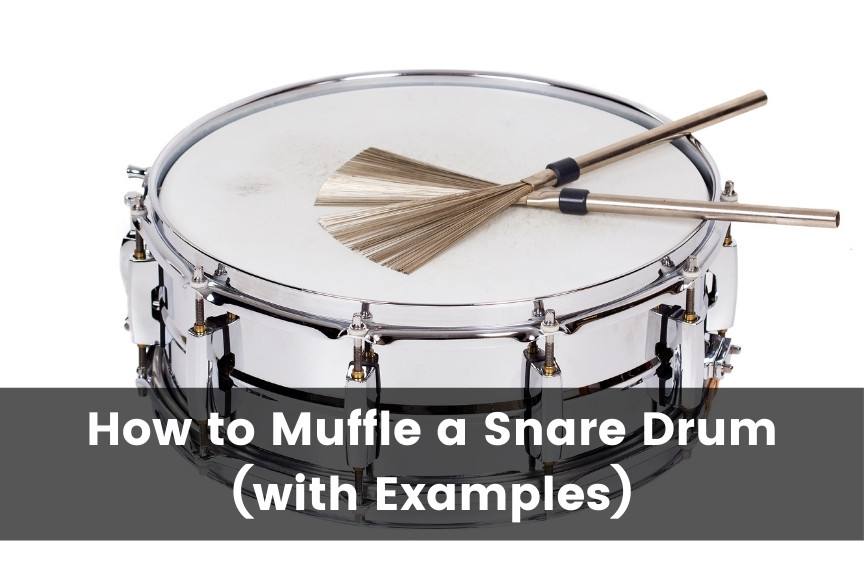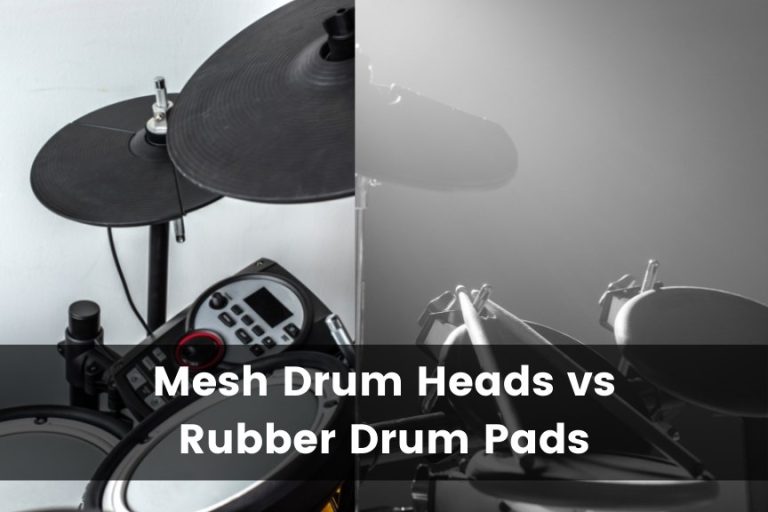How to Muffle a Snare Drum (10 Simple Ways)
It’s hard to come across a drummer who doesn’t muffle or dampen his drums at least a little bit. The truth is that our drums ring after we strike them, often more than we want. We need ways to cut down on that ring from our snare drums.
Here are 10 simple ways to muffle or dampen your snare drum:
- Use control dot drum heads.
- Adjust the built-in felt muffler.
- Use an aftermarket felt muffler.
- Get damper rings.
- Add gels and related solutions.
- Buy DrumClips.
- Use duct or gaffer’s tape.
- Set your wallet on the drum head.
- Use a kitchen towel.
- Use a practice pad.
Different mufflers perform different functions. Depending on your muffling needs and situation, some may be impractical or too expensive. If you are tired of your snare overtones or ringing, here are 10 simple ways to muffle a snare drum explained.
1. Use Control Dot Drum Heads
The easiest way to muffle your drums is to get drum heads that don’t need muffling. Depending on your needs, this may be the perfect solution. Drummers use control dot heads such as the durable Remo Emperor X Coated Drumhead (available on Amazon.com) for this purpose.
The manufacturer uses multiple plies when assembling the heads, and by adding the dot in the center embedding it within the layers, they’re able to build in some muffling qualities. Control dot heads have markedly less ring to them. The Remo Emperor X won’t eliminate all resonance from your drum, but it certainly cuts down the ring substantially.
If you want more muffling than that, you may find more draconian solutions below. After all, some drummers are only after the attack and are uninterested in the decay.
2. Adjust the Built-In Felt Muffler
Most snare drums have a muffler inside when you buy them. Looking at the outside of your drum, see the round, knurled knob. It connects to a screw assembly on the other side of the drum wall, and a felt muffler sits atop the contraption.
Turning the knob moves the felt closer to or away from the batter head, and you can see it happen (if your batter head isn’t clear, look through the resonant head, which is more likely to be see-through).
As with many things, this muffler’s greatest strength is also its greatest weakness. Or it can be. In addition to muffling your drum and helping to cut down on the resonant ring that follows a hit, the mechanism has the potential to change the drum’s pitch.
When you turn the knob to push the felt against the bottom of the batter head, you can still apply pressure and screw it in tighter once it’s made contact. Using force to the drum head will change its tension and raise your drum’s pitch. It won’t be by much, but it might make enough difference to be an issue depending on your situation.
Again, most quality snare drums have this muffler in place already, but if yours is broken or missing, or if you never had one in the first place, you may opt for an internal tone control system.
The ROSS Snare Internal Tone Control (available on Amazon.com) eliminates unwanted overtones. The best part of this tone control is that it won’t interfere with your kit set up and is highly adjustable to your required dampening.
3. Use an Aftermarket Felt Muffler
Felt will be a recurring theme here because it’s dense, it absorbs vibrations well, and it’s inexpensive. A clip-on version of the internal muffler removes easily, and if you need some serious muffling, you can conceivably use more than one.
The Mxfans Drum Damper (available on Amazon.com) works on the same principle as the built-in muffler above, but it pushes the felt from the top onto your batter head. It sticks a few inches in from the rim, though, so if you’re a wild player or your stick control isn’t fantastic, you might accidentally play the muffler rather than the drum every now and then.
This muffler is less than a permanent solution because it’s a clip-on. It won’t become a de facto part of your drum, and you probably won’t be able to put the snare drum in its case with one of these still attached. But you’re a drummer, and you already have to set up so much hardware. So what’s one more piece?
If you’re not crazy about felt or need a muffler to cover more than just a 2-inch (5.08 cm) circle, look into a Snareweight Tone Control Damper (available on Amazon.com). It’s got a metal bracket that slips onto the rim of the drum and holds a piece of leather on the batter head. You can adjust how much of the muffler sits on the drum, and Snareweight makes different sizes, as well.
4. Get Damper Rings
Here’s where we start having more options. As the last option, rings are external. Unlike the second option on the list, there are many configurations and materials to look for in damper rings. These are great for cutting the high-pitched ring of a snare drum without altering much of the reverberation of the head on the lower ends.
Translation: your drum will still sound like your drum, just with less ringing. Damper rings— the simplest ones— are plastic circles that lie atop your snare drum’s batter head. If you have a 14-inch (35.56-cm) drum, get a 14-inch (35.56-cm) ring.
It’ll cover the edge of your drum around its circumference, and adding this 1 or 1.5 inches (2.54 or 3.81 cm) piece of plastic makes a difference.
A basic solution (and “basic” doesn’t mean bad or lower quality in any way) is the Remo Dampening Rings (available on Amazon.com). This two-pack contains a 1 and a 1.5 inch (2.54 and a 3.81 cm) ring. If one doesn’t work the way you want, the other one surely will. If it doesn’t, then you’re looking for more muffling than a solution like a ring can provide.
So we turn to more substantial rings like the donut rings from Big Fat Snare Drum. The 14-inch (35.56-cm) Big Fat Snare Steve’s Donut (available on Amazon.com) covers more of the drum than the Remo rings do— this is a circle with a 6-inch (15.24 cm) hole cut out of the middle of it. Steve’s Donut muffles a whole lot more of those high-frequency rings and will cut down— at least a little— on the volume of your snare drum.
The Original of the Big Fat Snare Drum (available on Amazon.com) is the same as Steve’s Donut, but it’s not a donut. It doesn’t have a hole cut into it, so it covers and contacts the entire surface of the batter head. We’re talking the muffled-est muffling here.
5. Add Gels and Related Solutions
The damper rings, gels, and the like provide muffling options. Unlike the rings, adding more gels will further muffle your drum and allow you to fine-tune your muffling.
First in this category is the Moongel line of products. As far as this kind of muffler goes, Moongel is relatively ubiquitous. The Moongel pads feel like little pieces of Jell-o, only they’re more solid. They work like those sticky hands you used to get out of a gumball machine in that it’s a sticky, malleable, gel-like plastic that will stick to your drum wherever you put it.
The RTOM Moongel Damper Pads (available on Amazom.com) are small, so you can put them on your drum head out of the way so you won’t play it by accident. They’re squishy. Some people find them to have an off-putting consistency (I am one of those people), but they do work well.
My two main problems with these style dampers are:
- Because they’re so sticky, they collect dust pretty rapidly and get dirty. You can wash the pads with warm water, but still.
- It may stick to things like your music chart. I’ve often set a piece of music down on a drum to mark something on the chart but accidentally put the paper down on a pad. It’s a sticky mess.
A big plus with the Moongels is that adding a second one won’t drastically change things if one isn’t enough. You can experiment with the number of pads and with placement, as they easily go on and come off the drum head.
6. Buy DrumClips
Admittedly, I don’t care for drum clips, so let’s get that full disclosure out of the way. But someone likes them because they keep getting bought.
The DrumClip External Damper (available on Amazon.com) is a piece of rubberized plastic or plasticized rubber that does what its name says. It clips onto the rim of your drum, and clipping it on causes the flat end of it to sit on the drum head.
Because of the nature of the material (it’s softish), it absorbs rings. It doesn’t suck up a bunch of it because this is a small attachment. But if you’re not dealing with a lot of unwanted ring or you don’t want to eliminate a lot of ring in the first place, this little guy may be for you. It’s unobtrusive on your drum.
7. Use Duct or Gaffer’s Tape
And now we have arrived at the DIY section of drum muffling. Of course, it involves duct tape. The world’s premier solution to almost any problem, duct tape gets lots of jobs done, so what should drum muffling not be one of them?
But muffling goes beyond slapping a piece of tape on the head. And honestly, gaffer tape such as the Pro Tapes Gaffer’s Tape (available on Amazon.com) is better, as it’s much less likely to leave sticky residue on the drum when you remove the tape.
Tape by Itself
If you just stick a strip of tape on the head, yes, you’ll muffle it. You’ll kill some of the ring you don’t want from your snare. But there’s a better way, these are:
- Take a 4-inch (10.16 cm) length of duct or gaffer tape.
- Fold it in half, sticky side in, and stick an inch (2.54 cm) of it together.
- Stick the tape to the drum so that you have two 1-inch (2.54 cm) pieces of tape sticking to the drum and a 1-inch (2.54 cm) piece of tape sticking straight up from the head.
You may want to play with placement (moving the tape closer to the drum’s center will muffle more frequencies). The critical part here is the piece of tape sticking up. It’ll dissipate some of the energy of the drum head into the air, which will mask more ringing from the drum than just slapping that whole length of tape over the drum head.
Tape and a Cymbal Felt
It’s a rare drummer that doesn’t have some extra cymbal felts, such as the A-xctoe Cymbal Felt (available on Amazon.com). If you don’t have some, you’re asking for trouble, so get some. Anyway, duct or gaffer tape and a cymbal felt make a pretty great muffler, and it’s not a permanent change to your drum. Here are the steps:
- Tear off a piece of tape a little longer than twice the width of the cymbal felt.
- Fix the felt to the edge of one end of the length of the tape. DON’T wrap the tape around the felt.
- Hold the felt in the place where you want the muffler to sit on your drum (near the edge).
- Attach the other end of the tape to the drum’s rim.
When you play the drum, the energy from your stroke will knock the felt off the head, but since it’s taped in place, it won’t go flying. Instead, it will settle back on the drum head and kill some of that post-stroke ring in a simple and elegant fashion.
Tape and Tissue
A little more permanent than the felt trick just because this method takes more time, using tape and tissue adds a lot of muffling to the drum and can eliminate nearly all decay from your drum, leaving you with only the initial attack. For some drummers, that’s ideal.
You can use gauze, paper towels, facial tissue, even a paper napkin. The idea is to use a soft, vibration-absorbing material. You’ll need to fold it a few times, as more layers will absorb more sounds, and then tape it in place on your drum.
There are so many variables here. How big is the piece of tissue? How many times did you fold it over? How long is the tape you used? How much of the tape is on the drum head?
As a quick fix, using tape and tissue isn’t much of one because getting the sound you want can take a lot of trial and error. Once you get it right, well, you used tissue, so how long do you think it’s going to last? Especially if you sometimes hit it with that piece of wood in your hand?
8. Set Your Wallet on the Drum Head
When you sit down to a foreign set and have nothing but sticks and a need to muffle the snare, necessity drives you. This solution is so simple that it’s laughable, but it works. Why else would it be on this list?
Set your wallet on the drum head. It’s heavy enough to stay in place but not so heavy that it’ll alter the drum’s pitch. It’s got layers of fabric in it (and various pieces of plastic and maybe some paper, too) to absorb sound, and it’s not so big that it’ll get in your way as you play.
Hey, it works. I’ve done it myself.
9. Use a Kitchen Towel
When you need to completely cut overtones and decay, covering as much of the head as possible gets the job done. Taking a kitchen towel to your drum can work great. Don’t use a bathroom hand towel, as they’re generally thicker than a kitchen towel, and that thickness will interfere with your attack, cushioning the blows from your sticks.
If the towel gets draped over the whole drum, it’s unlikely to shift in position as you play, so with a towel big enough for it, you won’t find your drum suddenly uncovered because the towel fell off.
10. Use a Practice Pad
Why you need to muffle depends on your situation. You may need to muffle not just the ringing or the overtones but the volume of the drum itself. Maybe you live in an apartment, or maybe your daughter just got her first drum set, but you hope to retain your sanity through her teenage years.
Here’s where we turn to the practice pad muffler, a piece of drum equipment that serves two purposes. The CB Drums Drum Practice Pad (available on Amazon.com) is an unassuming piece of black rubber.
It sits on the drum head and covers its entire surface with soft, bouncy rubber. In the center, there’s a raised area that’s harder and has the consistency of a drum head but doesn’t have the volume of a drum head.
The idea is that playing on this gives the player a reasonable facsimile of the feel of a drum under her sticks, but it’s oh, so much quieter than a snare drum. It substantially reduces the volume and still delivers a natural drum feel.
Conclusion
We muffle drums in different ways for different reasons, and sometimes those reasons change as our venues play. Drummers have a lot of options, some costing more than others. As with most of drum life, experimentation is key to finding what works for you.







